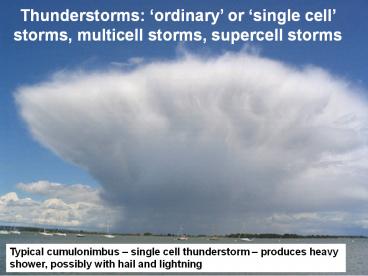Thunderstorms: - PowerPoint PPT Presentation
Title: Thunderstorms:
1
Thunderstorms ordinary or single cell
storms, multicell storms, supercell storms
Typical cumulonimbus single cell thunderstorm
produces heavy shower, possibly with hail and
lightning
2
Reading
- Ahrens, Chapter 14 Thunderstorms and Tornadoes
- This lecture next (Lightning, tornadoes) will
cover the topic.
3
What meteorological conditions precede a
thunderstorm?
- A conditionally unstable atmosphere
- Substantial boundary layer moisture
- A trigger to release the instability
- On a skew T-log p plotCAPEConvective
Available Potential Energy energy that can be
released - CINConvective INhibition energy barrier
that has to be overcome
4
(No Transcript)
5
(No Transcript)
6
(No Transcript)
7
Real example tephigram large amount of CAPE
thunderstorm v.likely
CAPE is given by thearea between SALR and
environmentallapse rate
CAPE
8
An important forecaster tool for predicting
thunderstorms Maps of CAPE (contours) and
vertical velocity ()
Fri Nov 7 12Z2008
http//expert.woeurope.eu/cape_frame.htm
9
(No Transcript)
10
Sunday 1200 (8 Nov 2009)
11
(No Transcript)
12
Monday 31 Oct 2011 (03z)
13
(No Transcript)
14
Ordinary or single cell thunderstorms
- Relatively small
- Isolated
- Typically just produce a single heavy shower,
then dissipate. - Very little vertical wind shear (come back to
this later)
15
Stage 1 Cumulus
16
Cumulus stage (continued)
- Buoyant updraught
- Vertical velocity increases with height, to 10
ms-1 at top - Surrounding air mixed in (entrainment)
- Inside cloud, raindrops and supercooled drops
grow, releasing latent heat - At edges, drops evaporate into entrained air
moistens the surrounding air. - As the environment moistens, successive
updraughts sustain clouds to higher and higher
levels - No rainfall at this stage
17
Stage 2 Mature
18
Mature stage (continued)
- Top of cloud extends to near tropopause levels
(gt10 km), well above 100 freezing level - Growth of drops ice continues until updraught
can no longer support them start to fall - Entrainment of surrounding drier air tends to
evaporate drops, cooling air - Both these processes lead to development of a
downdraught - Updraughtdowndraughtcell single cell
thunderstorm - Most intense stage heavy rain, thunder,
lightning - Anvil starts to form at top
-40C
10 km
5 km
0C
19
Stage 3 Dissipating
20
Dissipating stage (continued)
- Downdraught grows until it cuts off flow of air
to the updraught the storm has its fuel
supply stopped - Rainfall declines and the lower part of the cloud
evaporates - Rainfall stops all that is left is the anvil
- All 3 stages pass in typically about 1 hour - a
rapid, heavy shower
21
Summary single cell storm
Mature
Dissipating
Cumulus
22
Vertical wind shear
- Why might this be important?
23
Approaching mature stage
Dissipating stage
24
Multi-cell thunderstorms
- This type of thunderstorm is where once one cell
subsides, another grows in its place, adjacent to
the last cell - The downdraught causes a gust front when it
meets the surface. This may push up surrounding
moist air and trigger a new cell to develop. - The presence of vertical wind shear can help
thunderstorm development and persistence by
separating the updraught from the downdraught
25
Vertical Wind Shear
Shear tilts the storm, helping it propagate,
increases its lifetime and severity Promotes
formation of new cells i.e. a multicell storm
26
Shear and rotation
27
Horizontal shear combined withan updraught can
lead to a stormacquiring vorticity about a
verticalaxis
Vorticityassociatedwithhorizontalshear
28
Generating a supercell storm
29
Supercell, Kansas, rotating updraught
30
Supercell thunderstorms
- Rotating updraught
- Rotation causes the storm to be more robust
longer-lived, and therefore more dangerous - Forms an area of low pressure at centre of
rotation, called a mesolow - Updraught centred on the low pressure
- Circulation around the low is in cyclostrophic
balance































